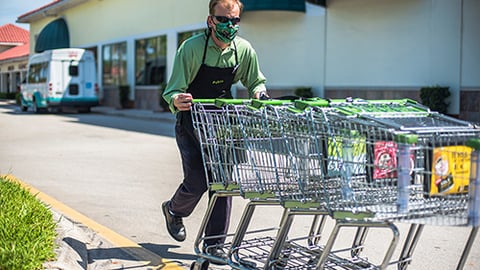Making Sense of 'Made in the USA'
Will the shortages of face masks, surgical gowns and hand sanitizers we’ve experienced during the ongoing coronavirus pandemic cause consumers to demand that more products be made in the United States?
Given the notoriously short memories of Americans, that remains to be seen. But what does “Made in the USA” really mean, anyway, and will the definition of that phrase change given the Federal Trade Commission’s (FTC) recent announcement of a proposed rule governing “Made in the USA” claims? A look behind the legislative landscape and a recent FTC enforcement action may offer some insights to manufacturers and retailers interested in making “Made in the USA” claims.
On April 1, 2020, in announcing a $1 million settlement it reached with Williams-Sonoma regarding “Made in the USA” claims on some of its products, FTC said:
"When we’re deciding between buying two products, if one product says 'Made in the USA,' does that influence how we make our decision? For many people, it does, and we all have a reasonable expectation that the claim is truthful. . . . 'Made in USA' is not a sales claim just any company can make. It is an objective representation that many consumers find highly relevant, and it requires solid substantiation."
Yet although the FTC has suggested “Made in the USA” claims are “objective,” the standard it has employed since 1997 hasn’t given manufacturers and retailers concrete guidelines on when “Made in the USA” or similar phrases can be used, making these so-called “objective” claims somewhat subjective and leaving manufacturers and retailers vulnerable to potential FTC enforcement actions and consumer class-action lawsuits. This has led many businesses to abandon “Made in the USA” claims on their products and in their advertising, even where their products meet the criteria to make such a claim. This, of course, results in fewer choices to those consumers seeking products that are made in America.
Consequently, many in the industry had hoped that FTC would clarify its standard with a more concrete and formulaic approach. Unfortunately, through its proposed rule — which is intended to codify its existing standard — FTC is maintaining the same subjective “objective” standard to measure the veracity of “Made in the USA” claims, while increasing the stakes to businesses that make unsubstantiated “Made in the USA” claims.
1997 FTC Policy Statement Regarding “Made in USA”
In 1997, FTC issued its policy statement regarding the use of “Made in the USA” and other statement of origin claims. FTC’s official position was (and still is) that “unqualified U.S. origin claims should be substantiated by evidence that the product is all or virtually all made in the United States.” Although its policy statement was not codified into an official rule, FTC has relied upon it to bring enforcement actions under Section 5 of the FTC Act, which prohibits “unfair or deceptive acts or practices.”
FTC’s policy statement, however, has not given definitive benchmarks to guide those seeking to make “Made in the USA” claims. According to FTC, a product that is “all or virtually all” made in the United States will ordinarily be one in which “all significant parts and processing that go into the product are of U.S. origin” and “should contain only a de minimis, or negligible, amount of foreign content.”
Even with this explanation, FTC acknowledged that there is no “bright line” rule to assess whether a product is “all or virtually all” made in the United States, and simply listed factors that could go into FTC’s analysis. In fairness to FTC, it is extraordinarily difficult to draft a single policy standard applicable to a range of products as diverse as acetaminophen and zippers.
On the other hand, it is unfair to expose businesses that chose to make “Made in the USA” claims to enforcement actions and litigation, and resulting civil penalties and judgments, without clear and concrete boundaries. Yet, since FTC issued its policy statement in 1997, it has issued 24 administrative orders and entered into four federal court settlements using that standard.
FTC’s Proposed Rule
In September 2019, FTC held a workshop to discuss, among other things, whether any changes were needed to its current guidance for “Made in the USA” claims. During that workshop, FTC did not find any support for updating its guidance. It did, however, find general agreement among the participants that there was no downside in issuing a formal rule on “Made in the USA” claims.
After the workshop, FTC issued a proposed rule on July 16, 2020. There are a few key takeaways for manufacturers and retailers if this rule ultimately goes into effect:
- The proposed rule does not change the standard that FTC has employed since 1997 in analyzing “Made in the USA” claims. Specifically, the rule provides that a manufacturer cannot make an “unqualified” “Made in the USA” claim unless (1) “final assembly or processing of the product occurs in the United States,” (2) “all significant processing that goes into the product occurs in the United States,” and (3) “all or virtually all ingredients or components of the product are made and sourced in the United States.” This rule simply codifies the existing policy statement upon which FTC has relied since 1997.
- FTC has clearly stated that the proposed rule is intended to “enhance” its “ability to obtain appropriate relief for consumers.” In other words, FTC has ensured that the proposed rule includes specific provisions that makes it easier for it to seek civil penalties against violators.
- FTC’s proposed rule provides that it supersedes any state rule to the extent that it is “inconsistent” with FTC’s rule. This provision will undoubtedly have an impact on businesses that market their products in California or nationwide. California has its own “Made in the USA” labeling law that is arguably less restrictive than the FTC’s proposed rule in that it allows up to 5% (and in some cases up to 10%) of the final wholesale value of the manufactured product bearing a “Made in the USA” claim to be foreign-sourced. On its face, the California statute appears inconsistent with FTC’s “all or virtually all” standard.
FTC’s proposed rule is not yet final, and it is soliciting comments until Sept. 14. However, as drafted, the proposed rule appears to increase the risk of enforcement actions and associated civil penalties without providing further guidance to businesses on how to comply with the existing “all or virtually all” standard.
FTC’s Proposed Rule’s Impact On Businesses
If enacted, FTC’s proposed rule will undoubtedly have an impact on businesses nationwide. While the proposed rule doesn’t deviate from FTC’s “all or virtually all” standard that has governed “Made in the USA” claims since 1997, it certainly raises the stakes for those who violate it.
To be clear, although businesses choosing to make “Made in the USA” claims should have always striven to comply with FTC’s “all or virtually all” standard, FTC enforcement proceedings against violators have been relatively rare. Acknowledging this, FTC’s proposed rule specifically contemplates enforcement actions and accompanying civil penalties, and FTC has outwardly expressed that the proposed rule is intended to enhance enforcement and its ability to seek civil penalties.
As a result, businesses would be well served by using the time before the proposed rule is enacted to audit their country-of-origin claims to assess compliance with FTC’s “all or virtually all” standard and California law. This includes ensuring records exist to substantiate the “Made in the USA” claim and receiving confirmation from component suppliers regarding the origin of the components.
Also, those choosing to make “Made in the USA” claims should keep in mind that the veracity of such claims may change over time due to a variety of issues, such as changes in suppliers and manufacturing processes. A once truthful “Made in the USA” claim can become false and deceptive and subject a business to enforcement action, litigation, monetary penalties and associated negative publicity by something as minor as the change of a small and seemingly insignificant component part or ingredient.
Consequently, businesses should employ policies to periodically reassess their compliance with FTC’s standard and proposed rule and California law governing “Made in the USA” claims and engage competent legal counsel familiar with country-of-origin labeling issues.







